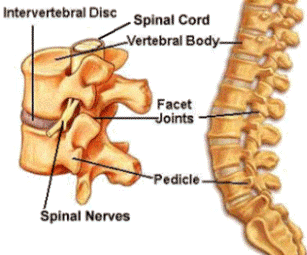Cancer prevention Guide
If you have been told you need surgery read the back surgery page

Back Pain section Go to back pain page
Lower back pain and bladder dysfunction
A 36 year old man presented with progressive low back pain and bladder dysfunction. He had had periods of non-specific back pain for more than a year. In the past two weeks the pain had got worse, radiating from the left dorsolateral thigh to the lateral site of his left foot. For three days he had had difficulties initiating micturation, and the flow had weakened. He felt numb sensations in the left scrotum, the perineal region, and on the lateral site of the left foot. He also noticed muscle weakness in the left foot. He had no history of trauma or recent disease.
General physical examination indicated a healthy young man. Neurological examination showed paralysis of the left foot extensors, motor weakness of left foot flexors (grade 2-3), and sensory deficits from the medial leg to the dorsal lateral foot. The patellar reflexes were vivid on both sides (left more than right). The ankle jerk was absent on both sides and plantar flexes indifferent. Rectal examination indicated saw saddle anaesthesia and low sphincter tone. Normal and crossed straight leg raising tests were positive at 50° at the left side.
Questions
(1) What worries you most in this case?
(2) What is the term for this complex of symptoms?
(3) What is the differential diagnosis?
(4) What would you do next for this patient?
(5) What are the features seen in the magnetic resonance image (figure1)?
Answers
(1) Alarms should go off when a patient presents with difficulties in urine and sensory loss in the buttock region. Other warning signs are the decreased sphincter tone and the motor and sensory loss in the left leg accompanied by acute worsening of backache.
(2) Cauda equina syndrome is caused by narrowing of the spinal canal: nerve roots become trapped and start to dysfunction. The array of symptoms can guide the investigator to the level of compression.
(3) All conditions resulting in compression can explain cauda equina syndrome. Consider trauma, disc herniation, spinal stenosis, neoplasms, spondylolisthesis, inflammatory conditions, and iatrogenic conditions.
(4) Start by taking an accurate history and a clinical examination to narrow the differential diagnosis. You should already suspect the diagnosis of central disc prolapse. Magnetic resonance imaging is the best diagnostic investigation because it can depict soft tissues. Consult the orthopaedic or neurological surgeon immediately for further treatment.
(5) The magnetic resonance image in the figure1 shows a massive herniated disc at the level of L4-L5 into the spinal canal. This view also shows some bulging of the disc at the level of L3-L4 and minor discopathy in the adjacent levels.
(6) Cauda equina syndrome to central disc prolapse at the level of L4-L5.
(7) The suspected diagnosis of central disc prolapse causing cauda equina syndrome is an investigative and surgical emergency. Surgical decompression should be performed as soon as possible to stop further neurological loss and improve clinical outcome. 1 2 3. The preferred method of decompression is laminotomy and partial discectomy.
continued on next page